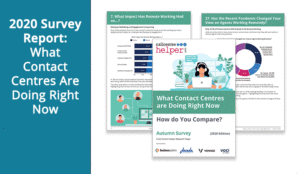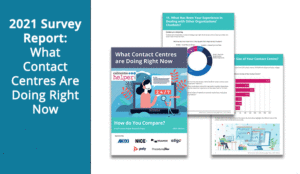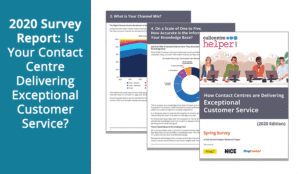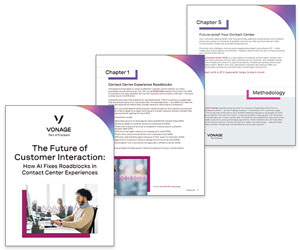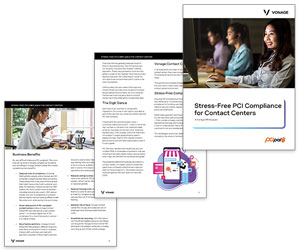Throughout September and October 2020, in partnership with Business Systems, Jacada, Voci Technologies and Vonage, Call Centre Helper readers were invited to take part in the second of our two industry-wide annual surveys.
2020 was an extraordinary year, the most challenging year that many contact centres will have ever faced and a year in which the industry has changed at an unprecedented rate.
For these reasons, this year’s version of our annual “What Contact Centres Are Doing Right Now” survey has produced some unexpected results.
As always, the aim of the survey was to capture a snapshot view of what contact centres are doing right now – and how things have changed!
The survey was circulated amongst Call Centre Helper readers throughout September and October 2020, and was run in partnership with Business Systems, Jacada, Voci Technologies and Vonage.
We also took the opportunity to compare the data with data collected over the past five years, as well as introducing some new, more topical, questions.
Each year, the survey provides the latest and most valuable insights into the fundamental framework of the contact centre. In doing so, it covers multiple topics, including customer trends, contact centre initiatives and the technologies that have made it on to every contact centre’s wish list.
310 contact centre professionals took part, and we are delighted to share the results with you.
Continue reading this article to discover some of the headline findings and the responses to the final question, or if you are interested in a specific chapter check out one of these extracts:
Alternatively you can download the full Call Centre Helper survey report ‘What Contact Centres Are Doing Right Now‘ here.
Executive Summary
Every year, changes to technology, processes and training transform the make-up of the contact centre. Add this to the impact of the COVID-19 pandemic, and the “typical” contact centre of today is much different than it was in 2019.
These developments have accelerated changes in how call centre agents work, digital customer experiences and cloud technology adoption.
However, change has also presented businesses with new challenges to overcome, and these can prevent contact centres from performing to their full potential.
Here are a number of useful conclusions that have been drawn from this year’s survey, which shine a light on how contact centres are performing in late 2020.
Remote Working Has Brought Lots of Benefits to Contact Centres
More of our survey participants reported that remote working has had a positive impact than those who said it had a negative impact, in each of the following areas:
- Contact centre communication
- Employee engagement
- Service quality
- Workforce management (WFM)
Yet, according to our findings, the area in which most contact centres found the most benefit from homeworking is employee well-being, with 41.3% saying it had a positive impact, and only 15.3% saying that it had a negative impact.
Over Half of Contact Centres are Still Offering Social Events to Their Team
Despite the continuing pandemic, it was good to see that 50.8% of contact centres are still actively arranging social events for their agents.
While many of these social events will likely be virtual, it’s great to see that contact centres are looking for fun ways to protect their team from the social isolation of remote work.
Other popular initiatives included: multiskilling advisors (81.7%), knowledge champions (63.6%) and buddying agents (60.6%).
Many Contact Centres Rushed to Install Virtual Assistants
When the pandemic hit, contact centres rushed into the cloud. But our research suggests that many also invested in virtual assistants.
This time last year, just 14.0% of contact centres had installed a virtual assistant, but now 30.8% have implemented the technology. An increase of well over 100%!
The increase in uptake is probably due to the hike in contact volumes that many contact centres experienced as the outbreak first spread across the globe.
Knowledge-Base Technology Has Also Risen Dramatically
Another technology that has been in high demand in 2020 is the knowledge base, rising from 60.5% of contact centres having installed the technology in 2018, to 71.2% in 2020.
Providing agents with support systems like a knowledge base can be very helpful for remote agents, who miss the face-to-face support available in the contact centre.
Other technologies that have increased in usage in 2020 include: call-back-from-queue solutions, call- scripting tech and process automation.
Customers are Becoming Ever More Demanding
When the pandemic first hit, there were lots of heart-warming stories of understanding customers sympathizing with agents for having to work from home and use new systems in the blink of an eye.
It appears, though, that this customer sympathy has run its course and customers expect smooth- running contact centres that have overcome the challenges of COVID-19.
In fact, 37.2% of industry professionals believe that customers have become even more demanding and that this customer trend has had a big impact on their operation.
Almost 40% of Contact Centres are Digging Into Their Schedule Adherence Stats
Agents being in the right place at the right time is fundamental to running an efficient contact centre, and schedule adherence is your key metric for tracking that.
However, 39.3% of contact centres take it one step further and research employee reasons for low schedule adherence to find solutions unique to their contact centre.
Other popular strategies for improving schedule adherence include: setting adherence targets (48.2%), publishing adherence reports (36.2%) and implementing real-time adherence notifications (29.0%).
Over a Third of Contact Centres Do Not Measure First Contact Resolution (FCR)
Despite 63.8% of our survey participants stating that they believe FCR is a “very important” metric, more than one in every three contact centres (34.0%) don’t measure it.
This could be due to the fact that FCR is difficult to measure and that there is no easy way to track multiple calls about the same issue.
There are, however, multiple methods for attempting to do so. Many of our industry professionals attempt to measure FCR through measuring repeat contacts (25.5%), tracking call reason codes (23.5%) and using an analytics system (8.9%).
Download the full Call Centre Helper survey report ‘What Contact Centres Are Doing Right Now‘ here.
Question 28: If There was One Thing That You Could Improve in Your Contact Centre, What Would It Be?
As you might expect, many of the responses to this question included investing in new technology, better communicating with the wider department and obtaining more budget.
Yet there were many other intriguing suggestions, which included:
Improving Remote Work
- Improve connectivity for work-from-home
- Boost schedule adherence rates for remote team
- Develop a new communication system and feedback loop
- Enhance relationships between agents and senior managers
- Improve onboarding process for new remote agents
- Offer more social activities for remote workers
- Hire more agents to share workload
Better Supporting the Team
- Arrange more fun activities for agents
- Build a proper reward programme
- Increase employee engagement and buy-in of processes
- Establish well-being as key business priority
- Improve the ratio of agents to coaches
- Make agent tools easier to use
- Carry out more training and coaching
- Offer great career-progression paths
- Simplify operational processes
Customer Service Strategy
- Align process with other departments
- Create a more personalized experience
- Engage emotionally with customers
- Provide greater consistency in this period of uncertainty
- Improve service levels
- Reduce call abandon rate
- Unify culture between support areas and business operators
Developing Contact Centre Management
- Refocus senior management priorities
- Improve allocation of resources
- Develop better leadership cohesion
- Boost procedural adherence
- Gain buy-in from stakeholders
- Develop customer retention strategies
- Enhance communication between the quality team and operations
- Improve leadership skills
- Improve recruitment strategy
- Move to a fully remote contact centre
- Perfect our staffing levels
- Reduce contact centre attrition
Implementing New Technology
- Apply more process automation
- Integrate the knowledge base better
- Create a single customer view
- Enhance agent desktops
- Fully integrate all customer channels
- Fully integrate the CRM
- Implement a WFM system with shrinkage reporting
- Implement screen-pop
- Improve self-service options
- Introduce a knowledge management system
- Introduce skill-based routing
- Install an omnichannel solution
- Install speech analytics
- Invest in quality monitoring tools
- Reduce manual manipulation of data
- Simplify contact centre reporting
Follow this link to view the full Call Centre Helper survey report ‘What Contact Centres Are Doing Right Now‘.
Alternatively if you are interested in a specific chapter read one of these extracts next:
This survey was done in partnership with Business Systems, Jacada, Voci Technologies and Vonage.
Related Research
To download the full copies of our ‘What Contact Centres Are Doing Right Now’ survey reports follow the links below:
- What Contact Centres Are Doing Right Now (2023 Edition)
- What Contact Centres Are Doing Right Now (2022 Edition)
- What Contact Centres Are Doing Right Now (2021 Edition)
- What Contact Centres Are Doing Right Now (2020 Edition)
- What Contact Centres Are Doing Right Now (2019 Edition)
- What Contact Centres Are Doing Right Now (2018 Edition)
- What Contact Centres Are Doing Right Now (2017 Edition)
- What Contact Centres Are Doing Right Now (2016 Edition)
- What Contact Centres Are Doing Right Now (2015 Edition)
You can also download the full copies of our ‘Is Your Contact Centre Delivering Exceptional Customer Service?’ survey reports by following the links below:
- Is Your Contact Centre Delivering Exceptional Customer Service? (2020 Edition)
- Is Your Contact Centre Delivering Exceptional Customer Service? (2019 Edition)
- How Contact Centres Are Delivering Exceptional Customer Service (2016 Edition)
For more great information check out our other Contact Centre Research
Author: Rachael Trickey
Published On: 17th Jan 2022 - Last modified: 12th Aug 2025
Read more about - Contact Centre Research, Benchmarking, Business Systems, Jacada, Research, Voci Technologies, Vonage





